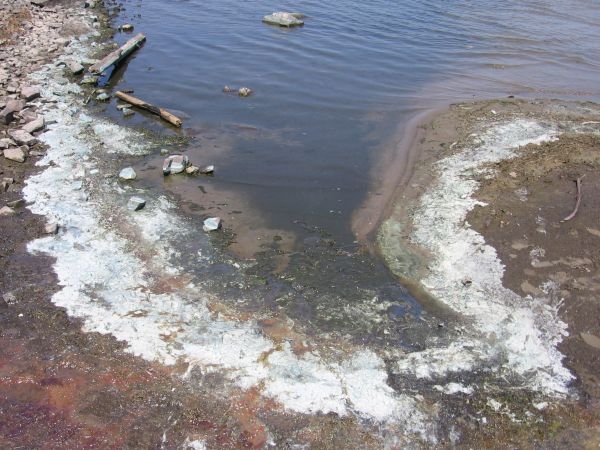
At Oakledge Park in Burlington a sign warns people to keep children and dogs away from the potentially toxic blue-green algae.
The blooms were thick here earlier in the week. And on Friday, they’re still visible in the water and dried crusts of algae coat the rocks.
Still, it’s sweltering and the lake is cool. And some people aren’t concerned about algae toxins. A swimmer who gives his name only as Art isn’t really sure what the fuss is about.
"I didn’t know anything about until I just read that sign," he says. ‘But I have no concerns about swimming. I’m going in in just a second."
Just off the beach, Linda Miller and her friends are cleaning out a barbecue grill after a picnic. For Miller, the water is definitely not inviting.
"We don’t swim here," she says.
Miller says she’s had experience with the algae blooms at her home in the Lake Champlain Islands.
"I live up in North Hero and there are lots of blooms up there," she says. "And our dogs, we have to keep them away from the water. And we don’t swim off the beach. We go out into the middle of the lake on our boat."
Blue-green algae have spread across a broad swath of Lake Champlain this summer. A quick tour of Burlington area by boat shows that the thick blooms seen earlier in the week have been mostly dispersed by the wind and waves.
But near Red Rocks Park in South Burlington, the blue greens are still visible as small paint-like scum lines in the water.
Louis Porter, a clean water advocate for the Conservation Law Foundation, says the blooms arrived earlier this summer and are more widespread, moving into the main body of the lake.
"And the reason for that is probably the record number of phosphorus inputs that came in through the streams last year," he says. "As you know last year was a record level of phosphorus coming into the tributaries of Champlain both because of the spring floods but especially because of Irene floods which washed a lot of sediment. There was a lot of bank erosion; it washed a lot of farm waste, manure, other things into the streams."
Phosphorus acts a fertilizer for the blue green algae, and it fuels their explosive growth. Porter says this summer’s blooms are a visible reminder of the need to control phosphorus pollution.
"And that phosphorus doesn’t go away right away. It can stay in the water column for quite a long time and cause blooms in the next year or even the next following years," he says.
The algae produce two kinds of toxins that the state Health Department is concerned about. State Toxicologist Sarah Vose says people should exercise caution and stay out of the water when blooms are present.
"We want them to trust their eyes. If the water looks scummy, avoid contact with the water," she says.
Vose also points out that toxins can persist in the water even after the visible blooms have dispersed.